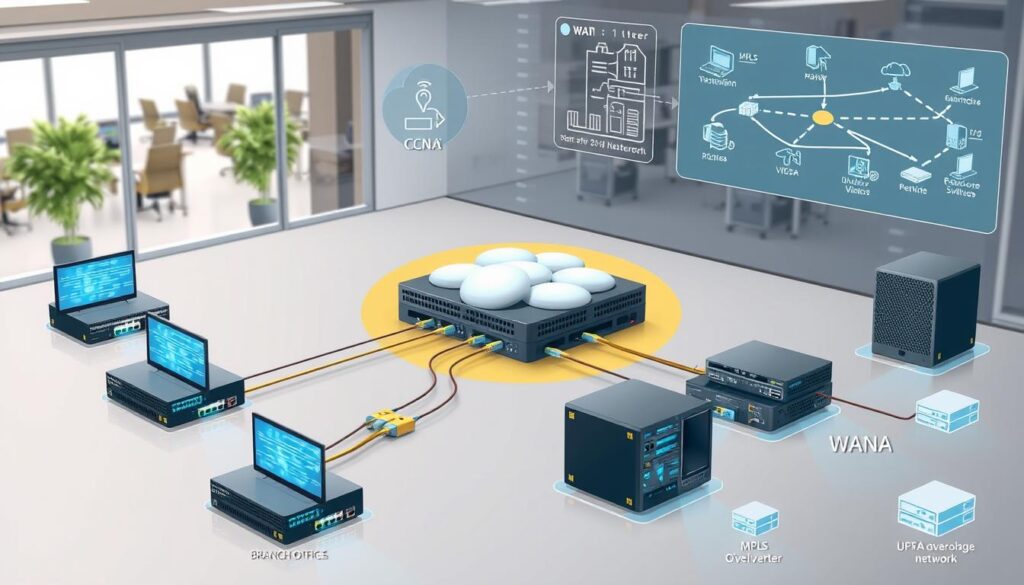Did you know that about 70% of organizations now use cloud-based WAN solutions? This shows how important Wide Area Networks (WANs) are for communication across different places. Learning CCNA WAN Technologies is key for businesses wanting to improve their work flow and network setup.
In today’s world, where people work from home more and companies have sites all over, knowing WAN Technologies for CCNA is critical. WANs help connect different parts of a company, whether it’s a branch office or someone working from home. Without them, different networks can’t talk to each other, making work hard.
Companies like SPAN Engineering show how fast WAN needs can grow. They started with one LAN but needed more as they grew. They needed flexible networks, using both dedicated lines and internet, to meet their needs. It’s clear that knowing CCNA WAN Technologies is key for companies to work well together.
Understanding Wide Area Networks (WAN)
A Wide Area Network (WAN) connects devices over long distances. It goes beyond local area networks (LANs). It links sites like businesses with many offices, distributors, or remote workers.
Definition of WAN
A WAN links different LANs together. It creates a single communication platform. It sends data, voice, and video over long distances, helping various organizations work together.
Using WAN Technologies for CCNA makes data sharing efficient. It helps businesses stay connected in a changing world.
Functions of WAN
WANs play key roles in today’s business world. Here are some important ones:
- Interconnecting enterprise LANs: WANs link different local networks. This ensures smooth communication across company sites.
- Transporting varied data types: It handles voice, video, and data. This offers complete communication solutions.
- Enabling branch operations: A strong WAN setup keeps operations running smoothly in regional offices.
- Supporting diverse communication needs: WANs adapt to growing projects and employees. They offer flexible communication options.
- Facilitating topological diversity: Different WAN topologies, like Point-to-Point and Full Mesh, meet various business needs and budgets.
In summary, WAN greatly impacts CCNA WAN Implementation. Knowing what WAN is and what it does helps make better choices in using WAN Technologies for CCNA.
The Importance of WAN in Modern Business
In today’s fast-paced business world, WAN services are key for connecting different locations. Companies often link their branch offices to headquarters to share data and work together better. With CCNA WAN Connectivity, businesses stay flexible, using various connections like dedicated lines and circuit-switched links.
Connectivity Across Multiple Locations
Companies in different cities or countries really benefit from WANs. High-speed options like T1 and E1 lines ensure smooth communication between offices. Fiber-optic media, like Dense Wavelength Division Multiplexing (DWDM), makes these connections possible by carrying over 80 channels on one fiber.
Government and schools use WANs to share important info and offer online learning. This wide reach is key to keeping work flowing smoothly and efficiently.
Supporting Remote Work and Telecommuting
Technology has changed how we work, making remote jobs common. With the right CCNA WAN Configuration, workers can access company resources from anywhere. For example, ISDN technologies allow for quick, secure communication, with setup times under one second.
WANs are more important than ever for supporting remote workers. Companies can use cloud-based WAN services to manage their networks better. This change helps employees work more flexibly and boosts business growth.

Implementing CCNA WAN Technologies
Setting up CCNA WAN Technologies is key for a strong and fast Wide Area Network. Knowing the main standards and protocols is vital for a good WAN setup. This part will look at the basics of CCNA WAN Implementation and why it’s important for today’s networks.
Overview of CCNA WAN Standards
The CCNA WAN standards guide in making reliable networks over different places. They mix the best practices and new solutions to keep up with tech changes. Knowing the latest, like Software-Defined Networking (SDN), is key. It keeps you up-to-date and helps you add automation to WAN systems.
Essential Protocols Used in CCNA WAN Technologies
Many important protocols are used in CCNA WAN Implementation. They are key for network connectivity and performance. Here are some main ones:
- High-Level Data Link Control (HDLC) – A bit-oriented protocol for sending data over serial links.
- Point-to-Point Protocol (PPP) – Used to carry many protocols over one link.
- Frame Relay – A top WAN protocol for remote site connections.
- Integrated Services Digital Network (ISDN) – Standards for digital voice, data, and video transmission.
Using these protocols right helps network admins set up and fix WANs. Knowing Quality of Service (QoS) is also key for better bandwidth use and network speed.
Essential Components for WAN Connectivity
Setting up a strong WAN network needs many key parts. Each part is vital for how well the network works. Knowing these parts helps you set up your CCNA WAN Setup well. It also lets you use the newest WAN Technologies for CCNA.
WAN Service Providers and Their Role
WAN service providers give leased-line connections for data. They are big in the network world. They make a lot of money from internet and voice services.
They must be reliable, with uptime of up to 99.999%. This is key for businesses to keep running.
Understanding Circuit-Switch and Packet-Switch Networks
Knowing about circuit-switch and packet-switch networks is important. Circuit-switching uses a dedicated channel for a connection. It’s good for apps needing steady bandwidth.
A T1 connection, for example, can handle lots of data at once. This is great for important traffic.
Packet-switching breaks data into packets. It’s cheaper for many businesses. It works well with different traffic levels. Choosing the right technology is very important for businesses.

| Type of Service | Speed (Mbps) | Cost (Monthly) |
|---|---|---|
| T1 | 1.544 | $300 – $1,500 |
| E1 | 2.048 | $400 – $1,600 |
| T3 | 45 | $2,500 – $5,000 |
| E3 | 34 | $2,000 – $4,000 |
More than 70% of companies use WAN optimization. Choosing the right technology and service is key. It makes networks better and helps with communication over long distances.
Configuration and Setup of CCNA WAN
Setting up a WAN follows a set of steps based on CCNA standards. Knowing how to make reliable connections boosts your network’s performance. You’ll learn about different setups, from simple point-to-point to more complex hub-and-spoke topologies. It’s important to know how to use Cisco routers for these setups.
Start by learning the key commands for CCNA WAN Configuration. These will help you through the process.
Step-by-Step Guide to CCNA WAN Configuration
The CCNA WAN setup has clear steps. This makes it easier to handle different setups with confidence:
- Planning: First, figure out what your organization needs. This includes how much bandwidth you need and if you want redundancy.
- Device Configuration: Next, get into the Cisco router’s CLI. Start with the basic settings.
- Protocol Selection: Then, pick the right WAN protocols. MPLS is good for managing bandwidth well.
- Implementing QoS: Use Quality of Service to make sure important apps run smoothly. This improves performance.
- Testing Connectivity: Last, test everything to make sure it works. This step helps with any CCNA WAN Troubleshooting.
Common CCNA WAN Setup Scenarios
There are many real-world examples of CCNA WAN technology use. Here are some common setups:
- Point-to-Point Connections: Great for direct links between two places. They offer dedicated bandwidth.
- Hub-and-Spoke Topologies: Perfect for companies with many branch offices. They all connect to a central site.
- Dynamic Multipoint VPN (DMVPN): Makes setup easier and improves network scalability.
- PPP Multilink Link Aggregation: Combines connections for better throughput and redundancy.
- WAN Optimization Techniques: These improve performance by reducing latency and caching content.
Challenges and Troubleshooting in WAN Environment
Setting up CCNA WAN technologies can bring many challenges. It’s key to spot common issues early to keep things running smoothly. Knowing these problems helps you fix them quickly.
Common Issues Faced During CCNA WAN Implementation
Most WAN problems come from mistakes in setup, like wrong IP addresses or security settings. This shows how important it is to set things up right. Also, about 70% of businesses using cloud apps or remote access face issues with performance and availability.
Effective Troubleshooting Techniques
Good troubleshooting methods can solve many problems. Checking the WAN link status is a must. Tools like ping, traceroute, and pathping help find issues in 60% of cases. It’s also vital to watch performance metrics.
Network latency is usually around 50ms, and packet loss can hit 5% during busy times. Using tools like SNMP or NetFlow can spot problems in 75% of cases. Documenting your findings can speed up solving issues by up to 35%. Keeping records up to date helps 85% of companies stay proactive with CCNA WAN Connectivity.
Conclusion
Adding CCNA WAN Technologies to your network is key for better performance and growth. As companies grow, they need better ways to connect. Using Cisco SD-WAN and MPLS makes data flow smoother and meets different business needs.
More businesses are using secure remote access, showing how important CCNA WAN is today. About 77% of companies use VPNs for safe communication. Also, with more demand for Metro Ethernet and packet-switching, keeping up with WAN tech is essential for staying competitive and saving costs.
Getting better at WAN technologies can lead to great career chances and help your company grow. Learning about CCNA WAN implementation is a smart move. It keeps you ahead in managing networks in a fast-changing world.
Source Links
- WAN Technologies Overview (2.1) > Cisco Networking Academy Connecting Networks Companion Guide: Connecting to the WAN
- Implementing and Administering Cisco Solutions (CCNA)
- WAN Technologies Overview (1.1) > WAN Concepts
- What Is a Wide Area Network (WAN)? – Spiceworks
- Selecting a WAN Technology (1.2) > WAN Concepts
- What Is a Wide Area Network, and Who Needs One?
- CCNA | Implementing and Administering Cisco Solutions v1.0 | Netec
- Implementing and Administering Cisco Solutions (CCNA) – Bvait
- WAN Technologies and Connectivity. Example of WAN – learncisco.net
- WAN Operations (2.1.2) > Cisco Networking Academy Connecting Networks Companion Guide: Connecting to the WAN
- [2025] CCNA Interview Questions on WAN Technologies
- How can you troubleshoot WAN issues?
- How to Overcome Common Challenges in Implementing Internet WAN Solutions
- Exploring WAN Technologies
- No title found
- Dayveed Peters-Nwokocha on LinkedIn: Mastering WAN Technologies: A Guide to CCNA Day 21 Understanding Wide…





